by Tony Heyes BSc (Physics), PhD (Physics), PhD (Psychology)
Knott End on the Lancashire coast near Fleetwood is 100 km from the Isle of Man. However occasionally one can see the Isle of Man from the Knott End foreshore. The tallest hill on the Isle of Man is Snaefell, the top of which is 621 metres above sea level.
The calculations below will show that because of the curvature of the earth an observer standing on the promenade at Knott End should only be able to see the top of Snaefell. And yet, just once in a while - when the conditions are just right - one can see not only Snaefell but almost the whole of the island.
If you are lucky enough to see it then what you are seeing is something really quite fascinating. You are seeing an atmospheric phenomenon, refractive looming or a Superior Mirage.
Let me explain.
Firstly, there is nothing superior about a superior mirage. It just means it is up there rather than down here.
We are all familiar with inferior mirages. These are the ones that occur on hot days. One sees what, to all intents and purposes, looks like a puddle of water in the road ahead. However, it stays ahead. Just like the end of the rainbow, it cannot be reached. The effect is caused by the bending of light rays. The air near the road is hot and has a lower refractive index to that of the air above. The layers of differing refractive index behave rather like an optical fiber; the image in the higher, cool, denser, air being reflected at the boundary with the lower, hot, less dense air.
|
An image of the palm tree is seen reflected in a pool of light from the sky. See NOTE at the bottom of this page. |
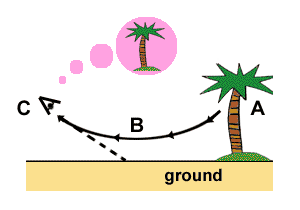
|
A superior mirage is a rarer event. It requires there to be a temperature inversion. This is when the air near the ground is colder than the air above. In the case of the sea it occurs when the water, and hence the adjacent air, is colder than the air above. In this instance the layers of differing refractive index cause the rays of light to be bent, and sometimes reflected, downwards. Under these conditions you can actually see over the horizon.
The literature tells us that superior mirages can take the form of towering, looming, and inversion, depending on the particular density structure of the air column.
However, being pedantic - and what scientist isn't - the title Superior Mirage should only be applied to the latter case. That is the case of the inverted image. Mirage is a French word meaning reflected image. Towering and looming involve the refraction of light. The inverted image involves the (internal) reflection of light. Strictly speaking, that alone is the Superior Mirage.
|
The image appears to be elongated |
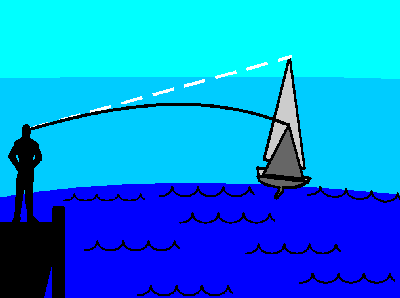
|
|
The Vikings see over the horizon.. |
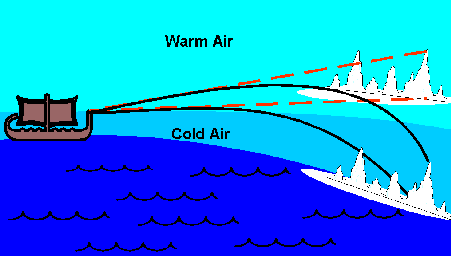
|
|
An inverted phantom image in the sky. |
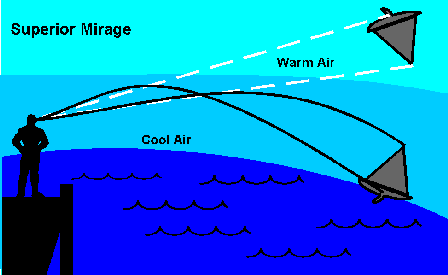
|
And there is yet another type of superior mirage, the fata morgana : a complex mirage in which distant objects are distorted as well as elongated vertically. For example, a relatively flat shoreline may appear to have tall cliffs, columns, and pedestals. The phenomenon occurs under much the same meteorological conditions as the superior mirage with inversion, and contains features of both towering and inversion.
Let us do a simple calculation.
Straight line distance between Knott End and Snaefell = 100 km.
Assume the Earth to be a sphere of diameter= 12742 km.
It can be shown that (See link).
D = 3.57 √ h
Where D is the distance to the horizon in km. seen by an eye h metres above the ground (or sea).
A pedant will notice that the above formula is not dimensionally correct. It gives, however, a very good numerical approximation to the correct answer.
Thus for a person of average height standing at the edge of the sea with toes in the water (h= 1.67 m)
the horizon is a mere 4.6 km. away, ie. approximately 3 miles in the old numbers.
For a person of the same height standing at the top of Snaefell h = 621 + 1.67 = 622.67
The horizon is some 89 km away.
These two people would NOT see each other (4.6 + 89 = 93.6 km. ) Whereas the actual distance between them is 100 km. !
The above calculation assumed mean sea level and a person with their toes in the water. Let us consider low tide and with the observer in Knott End standing on the promenade. Let us therefore assume that with respect to the sea level the person has grown by 6 metres, likewise Snaefell.
Our observer now has eyes 7.67 m above sea level and can therefore see 9.9 km out to sea. The top of Sneafell is now 627 metres above sea level and an eye at ground level(!) would see for 89 km. Adding these numbers together gives 98.9 km. Thus at low tide one should be able to see just the very top of Snaefell from the promenade at Knott End. And yet, when conditions are right, significantly more can be seen.
To summarize: In order to see the Isle of Man from Knott End it is not enough to have clear air and a low tide. One must also have an atmospheric temperature inversion.
Superior Mirages (know as the hillingar in Icelandic) are common in the Arctic and the Antarctic. They have played an important role in Arctic and Antarctic exploration. (Recall the need for a lower cold air layer). In other parts of the world they are less common. They occur most frequently after dark. Could car headlights seen over the horizon be interpreted as UFOs?
Some well known examples of seeing beyond the horizon are:
Seeing the Isle of Man from the Lancashire coast. (Seeing this in August 2005 inspired me to write this page)
Seeing the Melbourne central business district from Rye on the Mornington Peninsula.
Seeing the Norwegian mountains from the top of the Cairngorms in Scotland.
Seeing the mountains of Greenland from Iceland.
If you can add to my list or report any interesting related phenomenon please write to me:
tony.heyes@gmail,com
Note: Having written this page I then asked the experts to comment. In this context I am very grateful for stimulating input from Andy Young of the Department of Astronomy at San Diego University.
I live in Melbourne, Australia.
Seeing Melbourne from the foreshore at Rye is an interesting Atmospheric phenomena. I have seen looming. I have not, as yet, seen an inverted image.
Andy writes (September, 2005):
Finally, I'd like to urge you to show actual photographs of the looming of Melbourne as seen from Rye. With a telephoto lens, you just might discover there are some zones of the image that are inverted (i.e., miraged) after all. Usually the late spring and early summer are the best seasons for superior mirages, so you have some good opportunities coming up in the next few months.
Andy Young is also an expert on the related phenomena Green Flashes
I am delighted to have been sent the following picture by David Pennington taken in 2016 from Cleveleys (just south of Knott End) showing the Ise of Man seen behind the West_of_Duddon_Sands_Wind_Farm.
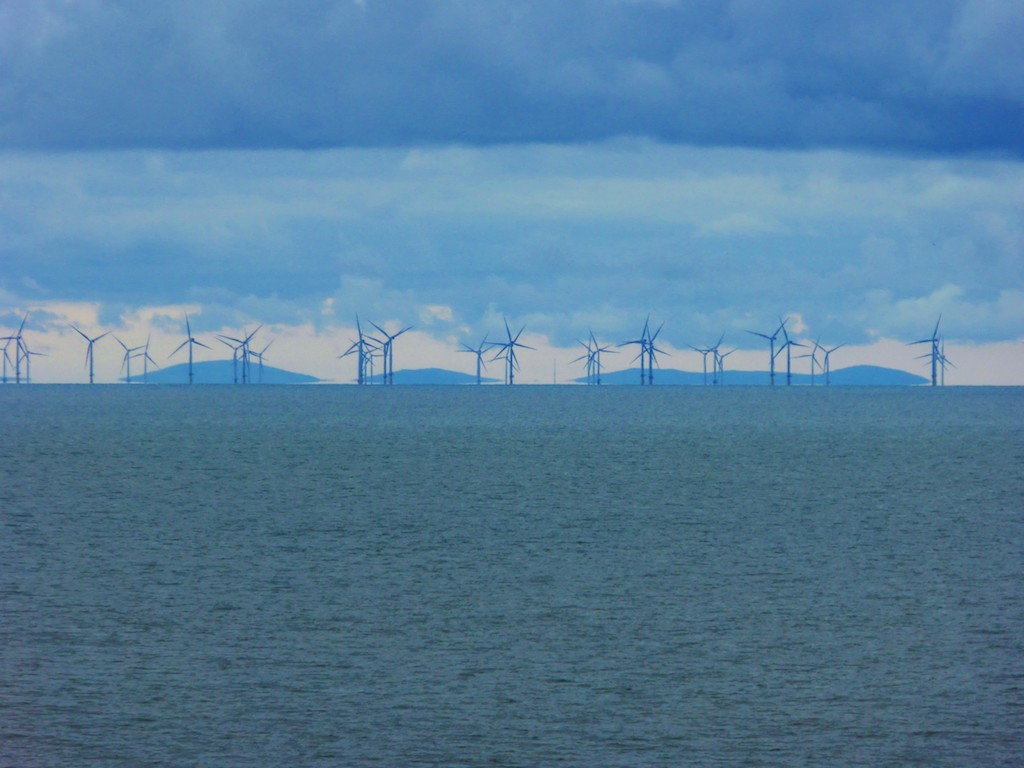
For further reading see:
Atmospheric Refraction
Refraction and Mirages
Walker 'stunned' to see ship hovering high above sea off Cornwall
In 2019 Jeffri Salleh sent me a photograph taken from Southport promenade showing the Isle of Man. The photograph is not especially clear but I do not doubt the veracity of Jeffri's observation. Jeffri also alerted me to a book written by Thomas Kirkland Glazebrook in 1826 'A Guide to Southport and North Meols' in which not only is the phenomena described, it is explained in terms of the refraction of light!